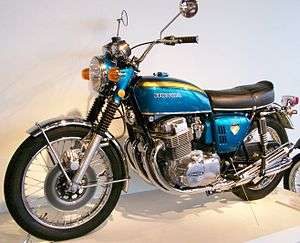Universal Japanese Motorcycle
Universal Japanese Motorcycle (UJM) is a US motorcycling media term for a general-purpose style of Japanese standard motorcycle that revolutionized the industry and made motorcycling in America more accessible during the 1970s and 1980s.[1] By around 1990 its popularity began to wane as the market fragmented into more specialized designs.

History
A defining example of the type,[2] the Honda CB750, was introduced in 1969 with an engine based on technology Honda had developed in Grand Prix racing.[3] It was the first production bike with disc brakes. Compared to the British and American models that then dominated the market, it had better performance and reliability, was better equipped, and yet was much cheaper. It revolutionized the industry both in America and abroad,[4] and sales in America immediately overtook those of big bikes from established brands like BSA and Triumph.[5]
The CB750's first Japanese competitor was the Kawasaki Z1 in 1972.[3] It was followed in 1976 by the Suzuki GS750 and by the Yamaha XS Eleven in 1978. These manufacturers all produced smaller versions of the same UJM formula, including, for example, the Honda CB500 of 1971.[3] By 1979 Harley-Davidson's big bike sales were down 90%.[6]
The first Japanese vehicle manufacturing plant in America opened in 1975 to produce the UJM Kawasaki KZ400.[7] Until then the bikes had been imported from Japan.
The term UJM appeared as early as 1976 in a Cycle magazine review of the Kawasaki Z650.[8] The term "universal" arose from the fact that the during the 1970s, the Japanese "big four" (Honda, Kawasaki, Suzuki, and Yamaha)[9] all produced very similar designs.[10]
The UJM was a general-purpose road bike, and the style went into decline in late 1980s and early 1990s[3] with the segmentation of the market and the development of niche products,[11] such as sport, dual-sport, touring, sport touring, café racers, and cruisers. Honda sold about 400,000 CB750s, and the model run ended in 2003 with the Nighthawk.
A market revival led by increased demand for simplified standard general purpose,[12] or naked[13] bikes has led Japanese manufacturers to introduce modern interpretations of the UJM, including the Honda CB1100,[14] Suzuki TU250X,[1] Suzuki GD110, [15] and the Yamaha SR400.[16]
Specification
The UJM had an advanced design and an excellent specification compared to contemporary European and American competition.[9] The press described it as cheap, reliable, easy to ride,[7] manufactured with precision,[17] and with a reputation for excellence.[18]
Technical specifications typically included a standard riding position, front disc brake, conventional tubular frame and telescopic front forks and twin-shock rear suspension. The engine was typically an inline four cylinder air cooled four-stroke transverse engine, with a carburetor for each cylinder, and single, or double, overhead camshafts. The unit construction engine was mated to a five or six speed manual transmission,[17] and had an electric starter.
References
- Pete Brissette (2009-10-06). "2009 Suzuki TU250X Review". Motor Cycle News. Retrieved 2016-07-14.
- Ford, Dexter (May 27, 2011). "You Meet the Nicest Sportbikes in the 250cc Neighborhood". The New York Times.
- Branch, Ben (2016-12-20). "A Brief History of the UJM - The Universal Japanese Motorcycle". Silodrome. Retrieved 2019-01-05.
- Alexander, Jeffrey W. (2009-01-01). Japan's Motorcycle Wars: An Industry History. UBC Press. ISBN 9780774858441.
- "Dick Mann's 1970 Daytona 200 Victory | Mann & Machine". Motorcyclist. Retrieved 2019-01-06.
- "Harley Davidson 1971 Crises ...{Strategos}". www.strategosinc.com. Retrieved 2019-01-06.
- Young, Roger T. (August 1994). "20 Years in America". American Motorcyclist. p. 30. Retrieved 3 January 2019.
- Connor, Andrew. "The Dawn of the Japanese Sport Bike". Gear Patrol. Retrieved 3 January 2019.
- Hetrick, Hans (2010). Sport Bikes (Full Throttle). Edge Books, Capstone Press. p. 12. ISBN 978-1429647519.
- Walker, Mick (2006), Motorcycle: Evolution, Design, Passion, JHU Press, p. 150, ISBN 978-0-8018-8530-3
- Frank, Aaron (2003), Honda Motorcycles, MotorBooks/MBI Publishing Company, p. 92, ISBN 978-0-7603-1077-9, retrieved 2010-02-20
- Maher, Kevin; Greisler, Ben (1998). Motorcycle Handbook. Haynes Publishing Group. ISBN 9780801990991.
- Young, Sid (2015). How to rebuild and restore classic Japanese motorcycles. USA: motorbooks. p. 8. ISBN 978-0-7603-4797-3. Retrieved 4 January 2019.
- "Honda Brings Back the Past with the 2013 CB1100 – a CB750 All Grown Up". thekneeslider.com.
- "Suzuki GD 110 – Charming, comfortable and able commuter". insideracing.com. Retrieved 2019-06-27.
- "2015 Yamaha SR400 | FIRST RIDE". Motorcyclist. Retrieved 2019-01-06.
- Neilson, Cook, ed. (November 1976). "Kawasaki KZ650". Cycle. 27 (11): 29–36.
- Domino, Kevin (2009). The perfect motorcycle : how to choose, find and buy the perfect new or used bike (Ed. 1.0 ed.). USA: 671 Press. p. 54. ISBN 978-0-9821733-3-6. Retrieved 4 January 2019.